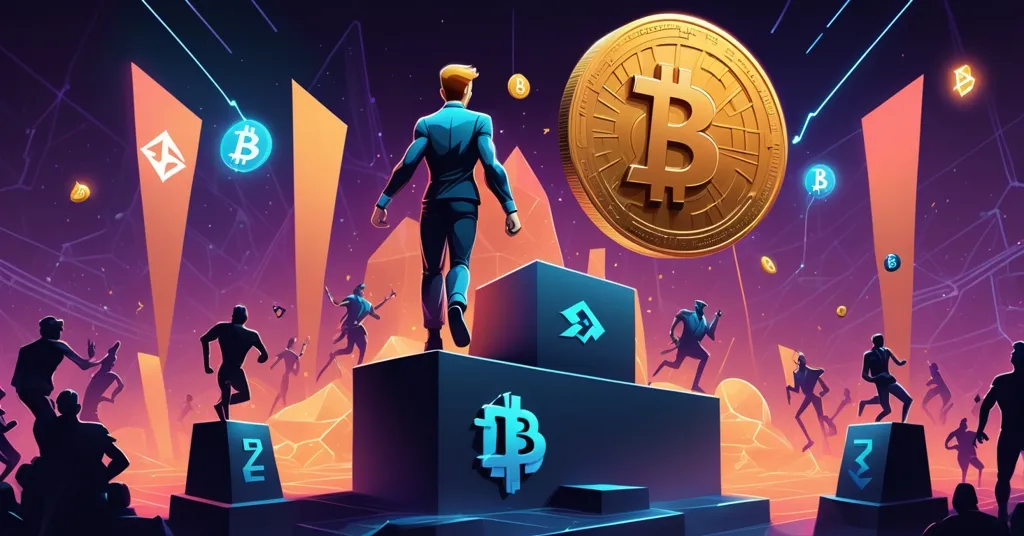BNB Surpasses XRP as Trader Nets $2M from CZ Tweet, LBRETT L2 Buzz Grows

BNB Knocks XRP Off the Podium as Trader Cashes In Big on CZ Tweet
BNB has just stormed past XRP to seize the third spot in cryptocurrency market cap rankings, while a sharp-eyed trader flipped $3,000 into a cool $2 million riding the wave of a tweet from Binance founder Changpeng Zhao (CZ). Add to that the buzz around Layer Brett (LBRETT), a new Ethereum Layer 2 project mixing meme culture with tech, and you’ve got a perfect snapshot of crypto’s split personality—steady giants versus speculative wildcards.
- BNB’s Power Move: BNB overtakes XRP as the third-largest crypto by market cap, driven by Binance’s sprawling ecosystem.
- Trader’s Windfall: A $3,000 investment balloons to $2M after CZ’s meme coin tweet sparks a frenzy.
- Layer Brett Buzz: Ethereum L2 project LBRETT raises $4.35M in presale with sky-high staking rewards.
BNB’s Rise: Why It Outpaced XRP
BNB, the native token of Binance—the heavyweight champion of crypto exchanges—has muscled its way to a market cap that now eclipses XRP, sitting at roughly $85 billion compared to XRP’s $32 billion as of late 2023 (per CoinMarketCap data). This isn’t just a random flip; it’s a testament to Binance’s iron grip on trading volume and the multifaceted utility of BNB. Think of BNB as the Swiss Army knife of tokens: it slashes trading fees on Binance, powers staking options, and fuels decentralized finance (DeFi) projects on the Binance Smart Chain (BSC)—a high-speed highway for crypto transactions built to handle massive throughput. This ecosystem strength draws retail traders and institutional players alike, pumping BNB’s value while XRP struggles to keep pace.
XRP, tied to Ripple’s mission of revolutionizing cross-border payments, has a different story. Its tech is designed for speed and low costs, partnering with banks and remittance firms to move money globally in seconds—think of it as a digital Western Union on steroids. Yet, despite this institutional appeal, XRP’s price has lagged, dragged down by ongoing regulatory battles, notably the SEC lawsuit in the U.S. alleging Ripple sold unregistered securities. This legal cloud, combined with a less retail-friendly narrative compared to Binance’s trading juggernaut, has dimmed XRP’s shine. The BNB market cap surge over XRP isn’t just numbers—it shows where value is flowing: to platforms that dominate user activity over niche payment solutions. For more details on this significant shift, check out the report on BNB surpassing XRP and the trader’s massive gain.
But let’s not crown BNB untouchable just yet. Binance’s centralized control over BNB raises eyebrows, especially when compared to Bitcoin’s decentralized ethos that we champion here. With regulatory scrutiny tightening—Binance faces probes and lawsuits worldwide, including SEC actions in the U.S.—there’s a lingering question: can BNB sustain this dominance if the hammer drops on its parent exchange? Unlike Bitcoin, where no single entity pulls the strings, BNB’s fate is tethered to Binance’s fortunes. It’s a powerhouse, no doubt, but one with a potential Achilles’ heel in a space that’s supposed to be about shaking off centralized overlords.
CZ’s Tweet: The Wild Power of Crypto Influencers
Switching gears to the chaotic side of the market, a single tweet from CZ, Binance’s larger-than-life founder with millions of followers, turned a trader’s modest $3,000 bet into a staggering $2 million. The catalyst? A passing mention of a meme coin—those joke-born cryptocurrencies that thrive on viral hype rather than any real utility like BNB or XRP. While the specific coin wasn’t disclosed in reports, the story is a glaring neon sign of social media’s raw power in driving crypto prices. One word from an influencer like CZ can ignite a feeding frenzy, sending prices to the moon overnight and minting instant millionaires—or, more often, leaving latecomers with empty wallets after the crash.
Let’s not sugarcoat this: chasing meme coin pumps after a CZ tweet is a sucker’s bet for 99% of traders. It’s not investing; it’s gambling in a digital casino where the house—or in this case, early insiders—usually wins. Meme coins lack fundamentals, riding purely on FOMO (fear of missing out) and community hype. For every jackpot story, there are thousands of silent losses from those who bought at the peak. And it begs an ethical question in a space built on decentralization: is this market freedom at play, or borderline manipulation by influencers with outsized sway? When a tweet can move millions in value, it’s hard not to see echoes of the centralized power crypto was meant to disrupt.
For newcomers, here’s a quick rundown of the risks in this speculative game. Meme coin trading often involves pitfalls like rug pulls—where developers abandon a project after collecting funds, tanking the price—or pump-and-dump schemes, where insiders hype a token to inflate its value before selling off, leaving others holding worthless bags. Timing is everything, and most retail traders lack the insider edge or luck to cash out before the inevitable drop. This isn’t to rain on anyone’s parade, but a harsh reminder: in crypto’s wild frontier, fortunes are as easily lost as they are made.
Layer Brett (LBRETT): Meme Culture Meets Scalable Tech?
Bridging the gap between utility and speculation is Layer Brett (LBRETT), a new Ethereum Layer 2 project that’s turning heads with its quirky blend of meme culture and serious infrastructure. For those unfamiliar, Ethereum, the second-largest blockchain by market cap, is a powerhouse for smart contracts and DeFi but suffers from high transaction costs—known as gas fees, essentially tolls for using its network—and slower speeds during peak demand. Layer 2 solutions are like express lanes built on top of Ethereum, designed to process transactions faster and cheaper while still tapping into Ethereum’s rock-solid security. LBRETT aims to deliver just that, promising near-instant, low-cost transactions with a playful meme-driven community twist—imagine Dogecoin’s humor paired with actual tech chops.
The project’s early traction is hard to ignore. It’s raised over $4.35 million in its presale phase, a clear signal of investor interest, and is dangling eye-popping staking rewards exceeding 600% APY (annual percentage yield)—a return rate that calculates your yearly earnings if you lock up tokens to support the network. That number screams opportunity, but let’s be real: it also blares “high risk” louder than a siren. LBRETT’s roadmap adds more intrigue, with plans for non-fungible token (NFT) integrations—unique digital assets for art or gaming—and gamified staking to keep users hooked. There’s even a $1 million community rewards pool to sustain momentum post-exchange listings. Some analysts are whispering about 50x to 100x returns if LBRETT catches a viral wave like early Dogecoin or Shiba Inu did. Tempting? Sure. Realistic for most? Hardly—it’s more lottery ticket than safe bet.
Now, let’s flip the coin and look at the red flags. Staking rewards at 600% APY are often unsustainable, potentially funded by new investor money in a way that smells like a Ponzi setup if user growth stalls. Presale projects like this also carry transparency risks—details on the team or tokenomics (how tokens are distributed and managed) aren’t always clear, and many such ventures have crashed to zero after hype fades. Compare this to failed meme or Layer 2 projects of the past, and skepticism is warranted. Could LBRETT dilute its credibility by leaning too hard on meme appeal over tech? Possibly. Yet, there’s undeniable optimism in Ethereum L2 projects as a whole—they’re critical to scaling blockchain for mass adoption. LBRETT might just be a wild experiment worth watching, provided you approach with a hazmat suit for your wallet.
Crypto’s Dual Nature: Giants, Gambles, and Bitcoin’s Shadow
Zooming out, these stories—BNB’s steady ascent, a trader’s meme coin jackpot, and LBRETT’s speculative allure—lay bare the bipolar nature of the crypto market. On one side, you’ve got established players like BNB, backed by real utility and massive liquidity, offering a foothold of stability in a sea of volatility. On the other, there’s the high-risk, high-reward chaos of meme coins and untested presales like LBRETT, tempting dreamers with visions of overnight wealth but delivering heartbreak just as often. It’s a financial rollercoaster where tech innovation collides with raw emotion, and FOMO can override logic in a heartbeat.
As Bitcoin maximalists at heart, we can’t help but view this through the lens of BTC’s store-of-value narrative. Bitcoin stands as the unshakeable foundation of decentralization—untethered to any exchange or influencer, unlike BNB or meme coin pumps. Are altcoins like these distractions from the true financial revolution, or necessary experiments filling niches Bitcoin shouldn’t touch? BNB’s centralized roots clash with our ethos of freedom and privacy, while meme coin madness feels like a circus sideshow. Yet, Ethereum L2 projects hint at a maturing space where scalability could drive real-world use—something even Bitcoin can’t fully tackle. The jury’s still out, but one thing is clear: navigating this landscape demands a steel stomach and relentless skepticism.
Key Takeaways and Questions
- What fueled BNB’s climb over XRP in market cap rankings?
BNB’s surge to $85 billion is driven by Binance’s dominance, with utility in trading fee discounts, staking, and DeFi on Binance Smart Chain, while XRP, at $32 billion, lags due to regulatory hurdles like the SEC lawsuit and weaker retail appeal. - How impactful are crypto influencers like CZ on market prices?
Hugely impactful—CZ’s tweet about a meme coin turned a trader’s $3,000 into $2 million, proving social media can trigger explosive short-term gains, often at the expense of late entrants. - Why is Layer Brett (LBRETT) catching investor attention?
LBRETT blends meme culture with Ethereum Layer 2 tech for fast, cheap transactions, raising $4.35M in presale and offering over 600% APY staking rewards, though such returns signal significant risk. - What does the split between BNB and meme coins reveal about crypto investing?
It highlights a dual market—BNB offers stability through utility and liquidity, while meme coins and presales like LBRETT dangle massive upside with equal chances of catastrophic loss. - Is BNB’s centralized model sustainable long-term?
Uncertain—while powerful now, BNB’s reliance on Binance, a centralized entity facing global regulatory heat, poses risks compared to Bitcoin’s decentralized resilience. - Are meme coin windfalls a viable strategy for most traders?
No way—success stories are outliers, and most get burned buying into hype at peak prices, making these plays pure gambling rather than sound investment.
So, where do you stand in this wild crypto arena? Will you anchor to steady giants like BNB, roll the dice on the next meme coin tweet, or cautiously eye experiments like LBRETT? The choice is yours, but remember: in a market this untamed, there are no guarantees—only calculated risks and a hell of a lot of noise. Stay sharp, question the hype, and never fall for shills promising easy 100x returns. Crypto’s a frontier, not a fairy tale.



